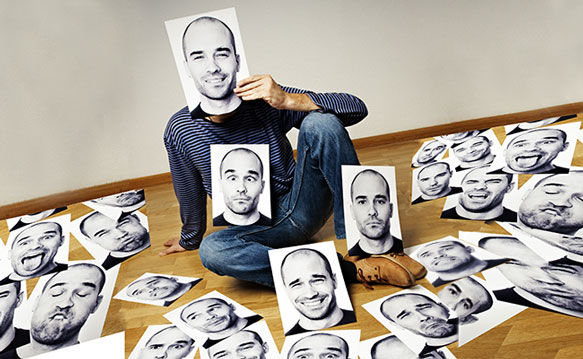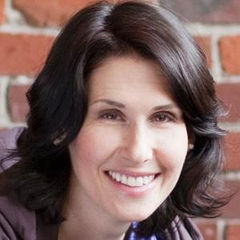
When you step in front of a group to teach a fitness class, do you present yourself in exactly the same way you would at home with just your family around? Or do you play up certain aspects of your personality to create a public identity or instructor persona? Trying out a persona doesn’t have to be about cloaking yourself behind a façade (although that’s one definition). Merriam-Webster defines the word as “the personality that a person projects in public.” So what’s your most public personality?
Any in-class identity might be a slightly embellished or emboldened version of your genuine self. Some instructors rely on a persona to comfortably step out of an otherwise introverted personality when they teach. Others feel quite at home on stage, but recognize that putting on a good show for participants helps motivate them to work harder and return to class each week.
It’s not about acting fake or trying to be someone else. Refining your unique instructor persona can improve your skills as an educator and motivator, allowing you to strongly connect with participants and bring your teaching to life. Here’s how a roundup of successful instructors describe it.
The Benefits of Teaching With an Instructor Persona
You might have already adopted an instructor persona, even if you haven’t given it much thought. For many instructors, a public personality develops organically, either from experience or necessity (or both).
“[A persona] gives permission to be more confident or outrageous than you feel you actually are,” says Alexis Craig, owner of Alexis Craig Fit and TRX Senior Course Instructor in San Francisco, Calif. “You can embody a confident, consistent leader, even if you feel doubt about actually being one.” This approach is especially useful for new instructors who are still figuring out best practices.
But even experienced, self-assured instructors have off-days and challenges at home or at work. In times like these, it helps to fall back on a dependable instructor persona. “Even if I am exhausted or grumpy or heartbroken, I will perform well when I teach my class,” says Craig, who has been teaching dance for 25 years and group fitness for 12. “I can put on the music and focus on delivering an excellent experience no matter what.”
Craig adds that having an established persona creates consistency, which helps grow class numbers. “If you just teach according to your mood every day, people won’t know what to expect when they come to your class, and they won’t feel as safe there,” she says. “Consistency is key to building a following.”
An instructor persona—or personas, as some instructors say they’ve cultivated several—can help you deliver the best experience possible for yourself and your participants. Lauren Matheson Ryan uses her persona to express a joy for teaching despite an aversion to public speaking. “I am typically introverted and shy, with a great dislike of public speaking (to the point of racing heart, sweating and breaking out in hives),” says Ryan, who is the Health Club Coordinator for Hytrol Conveyor Company in Jonesboro, Ark., where she teaches Insanity LIVE!, Zumba, water aerobics, circuit training and more. “But when I teach classes, it’s an entirely different experience for me. I can talk, yell and dance around with no problem!”
It’s a similar story for Michelle Felzmann, a fitness instructor, presenter and Master Instructor for TRX in Calgary, Alberta. “I am a quiet person at home and around friends,” she says. “However, when I step on a stage and put my headset on to teach, I completely change! My fitness persona is very different from who I am every day, and I believe it comes from the excitement of helping people make lifelong changes and the determination to deliver a program with the upmost enthusiasm.
Robin Gillespie is a personal trainer and instructor in Philadelphia, Pa., where she created her own Beyoncé-themed signature class called Bey Body Intervals. Describing herself as shy and quiet by nature, Gillespie uses an “alter ego” when in class that she has playfully named Miss Robin. “Miss Robin is energetic, confident, funny and loud,” she says. “I definitely have different levels of Miss Robin-ness for all of the classes I teach.” For example, you’ll find a mellower version of Miss Robin in Pilates than in cycling or boot camp.
Of course, the benefits of an instructor persona aren’t just for introverts. Craig describes herself as quite the opposite: “I am a high-energy type of person, a natural extrovert and an exhibitionist. I love having everyone’s attention and putting on a show,” she says. For Craig, adopting an instructor persona is about expressing herself according to the tone or style of class. “It is very important to me that I remain authentic no matter what class I am teaching, but as I am a multidimensional woman, my authenticity has a range of tones to choose from,” she says.
“When I teach yoga, I am Goddess Alexis,” Craig continues. “I put on feminine music and speak softly and slowly. I give nurturing cues and make sure there is a tone of love in my voice. When I teach kids classes, I am Alexis the Clown. I use my body to cue a lot, and love to do silly things like jump over people or do handstands to keep everyone engaged and paying attention.”
Ryan agrees that an instructor’s outward personality should be situation-specific. “I use different personas in different classes,” she says. “I wouldn’t teach a mind-body class with the same voice and persona as I would a high-intensity cardio class.” In fact, your instructor persona can guide you toward the classes you are most suited to teach.
Shirley Archer, J.D., M.A., is a personal trainer, fitness instructor and author of 15 books, including ACE’s Pilates Mat Training. She divides her time between Los Angeles and Zurich, Switzerland. “The advantage to becoming very clear about what personality you want to project into your teaching style is that you can…identify your niche—what class styles, what type of client, even what time of day,” Archer says. Some classes, clients and time slots require a teacher that exudes either more or less dynamism: Compare the tone needed in a 6:00 a.m. cycling class to that needed in a lunchtime stretch class.
Ultimately, drawing on a persona helps you amplify the message of fitness. “Sometimes when I teach group exercise, I feel like I am an exercise evangelist rather than a fitness instructor,” says Craig.
What is Your Instructor Persona?
Instructor personas can be multifaceted, but they tend to emerge from your most genuine traits, interests and passions. While you might infuse your classes with elements from several of the examples below, you likely gravitate toward a particular style. Here are a few examples that might strike a chord (there are many others not mentioned here).
 Party Person: Your classes are high energy and always full of fun and laughter.
Party Person: Your classes are high energy and always full of fun and laughter.
 Motivational Speaker: Channeling your inner coach, you inspire participants to dig deep and reach challenges they might not have thought possible.
Motivational Speaker: Channeling your inner coach, you inspire participants to dig deep and reach challenges they might not have thought possible.
 Science Buff: You motivate participants to get the most out of fitness with your explanations of the why behind each exercise.
Science Buff: You motivate participants to get the most out of fitness with your explanations of the why behind each exercise.
 Posture Perfectionist: Slouching and faulty form in class? Not on your watch. Progress is built on a foundation of good technique, and your participants know it.
Posture Perfectionist: Slouching and faulty form in class? Not on your watch. Progress is built on a foundation of good technique, and your participants know it.
 Music DJ: You spend hours compiling new playlists that you know your participants will love. In concert with all your training and skills as an instructor, you draw on music to elevate energy and motivation in class.
Music DJ: You spend hours compiling new playlists that you know your participants will love. In concert with all your training and skills as an instructor, you draw on music to elevate energy and motivation in class.
Connecting to Participants Through Your Persona
While an instructor persona can boost confidence, reduce social anxiety and/or help you project impressive energy, perhaps its biggest benefit is the positive impact it can have on participants. Your truest instructor personality will attract participants that are the best fit for you—and you for them. The result: You’re able to reach and help more people.
Archer explains this concept well: “I’m best as a mindful movement instructor, helping people to connect mind, body and breath and really ‘feel’ what they’re doing. My style and persona attract a specific type of client, who is ready to make that connection. Some people are very uncomfortable with their bodies and do not want anyone to make them feel what’s going on within. And, that is O.K. But I’m not the right instructor for that person, because I take my students on an inner journey, as well as a physical experience,” says Archer.
Your outward teaching style connects you with your ideal clientele. “As service professionals, we are designed to serve a very special and specific type of person,” says Sean Cristea, a Saint Louis, Mo.–based personal trainer, instructor and contributor to The Master Mind Project, an online mentoring company for fitness pros. “The more authentic and real you portray yourself through your services, the more attracted this type of person will be toward your class,” explains Cristea, who teaches youth athletic conditioning, HIIT classes and boot camps. The key is to pursue a persona based on authenticity versus a façade that doesn’t properly reflect who you are. “When people sign up for my classes or services, they don’t buy my training, they buy me,” says Cristea. “They buy my personality, my charisma and the experience I provide during the class. Because of this, I always boldly express myself through my services and business.”
Having a compelling persona not only draws people to you as an instructor, it also makes your classes one of a kind. “There could be 20 of the same type class on a schedule,” says Ryan, “but if you are able to present your class in an entertaining and effective way, people will come to your class.”
How to Shape Your Persona
A well-cultivated instructor persona is usually born out of some aspect of your personality, driven by a passion and excitement to share your skills and knowledge with people who need it.
For some, an instructor identity emerges naturally, as has been the case for Craig. “I am always larger than life when I am teaching class,” she says. “These personas are still authentic to different parts of me, but it is almost as if I am acting as myself on a stage. I make everything big and exaggerated so that everyone else can channel my energy.”
Other instructors might have to play around with technique to see what’s synergistic. “I recommend that instructors try a variety of styles, like trying on outfits—cheerleader, drill sergeant, coach, dance teacher or even therapist—and see what feels ‘right,’” says Archer. “Use this process to find your unique voice and individual movement style. When you feel good about yourself and your classes are full and successful, you will know that you have hit the sweet spot of meeting market expectations while expressing your personal vision.”
Although you want to do your best to adapt to the needs of your participants, avoid trying to be something you’re not—and that includes imitating other instructors. “It is O.K. if you aren’t a natural drill-sergeant type or not the natural ‘charismatic, funny, always making people laugh’ instructor,” says Cristea. You’ll want to safeguard against projecting a persona that feels strained or too over the top.
Early in her teaching career, Archer says she grappled with finding her personal style. “I literally copied some of the best instructors that I had seen at conferences and on videos or TV. I would even have program directors tell me that I had to incorporate more ‘dance’ moves or mix-up my choreography as I always had a more athletic style,” she recalls. “I would try this, but I never was as good or as popular as some of the other instructors because it really wasn’t me. Eventually, I gave up classes that weren’t working for me and did not work for program directors that would not allow me to teach in my own style using my individual persona.”
Overreaching for a certain type of persona doesn’t do much for creating rapport between you and your participants and could lead to dwindling class numbers, decreased enjoyment and burnout. It’s possible that some groups might simply demand more energy from you than you have to give. “This can be mentally exhausting,” Gillespie points out.
It’s O.K. to acknowledge that you aren’t the right instructor for a certain class—having a strong instructor persona helps make such an observation easier. Go with what feels right.
“If you fake it, people will see that,” says Felzmann. “If you have a true love for something, it will shine through, and your persona when teaching will be genuine.”





 by
by 

 Party Person: Your classes are high energy and always full of fun and laughter.
Party Person: Your classes are high energy and always full of fun and laughter. Motivational Speaker: Channeling your inner coach, you inspire participants to dig deep and reach challenges they might not have thought possible.
Motivational Speaker: Channeling your inner coach, you inspire participants to dig deep and reach challenges they might not have thought possible. Science Buff: You motivate participants to get the most out of fitness with your explanations of the why behind each exercise.
Science Buff: You motivate participants to get the most out of fitness with your explanations of the why behind each exercise.  Posture Perfectionist: Slouching and faulty form in class? Not on your watch. Progress is built on a foundation of good technique, and your participants know it.
Posture Perfectionist: Slouching and faulty form in class? Not on your watch. Progress is built on a foundation of good technique, and your participants know it. Music DJ: You spend hours compiling new playlists that you know your participants will love. In concert with all your training and skills as an instructor, you draw on music to elevate energy and motivation in class.
Music DJ: You spend hours compiling new playlists that you know your participants will love. In concert with all your training and skills as an instructor, you draw on music to elevate energy and motivation in class. 



